While the W trek may be what brings the hordes to the park, the O Circuit is Torres del Paine National Park’s undisputed gem.
Untouched landscapes of Magellanic forests, a rich array of wildlife, and more glaciers per day than is probably your fair ratio, this trek goes above and beyond what the W can offer – and you get to finish with the torres themselves anyway.
What’s more, it’s a far quieter route. Since 2017, the O Circuit has only allowed a daily visitor number of 70, which might seem a lot, but in practice means you are unlikely to bump into too many others until you reach camp at night.
As a result, there’s more opportunity for catching a glimpse of the native Patagonian fauna, including guanaco and even pumas, and more time for taking photos free of other hikers. Magic.
I’ve visited the national park on a number of occasions and had the fortune to hike both the W and the Circuit.
Therefore, this guide to the O Circuit in Torres del Paine National Park aims to show you how you arrive prepared for this trek, with everything from booking campgrounds, to sorting food and planning your equipment list included.
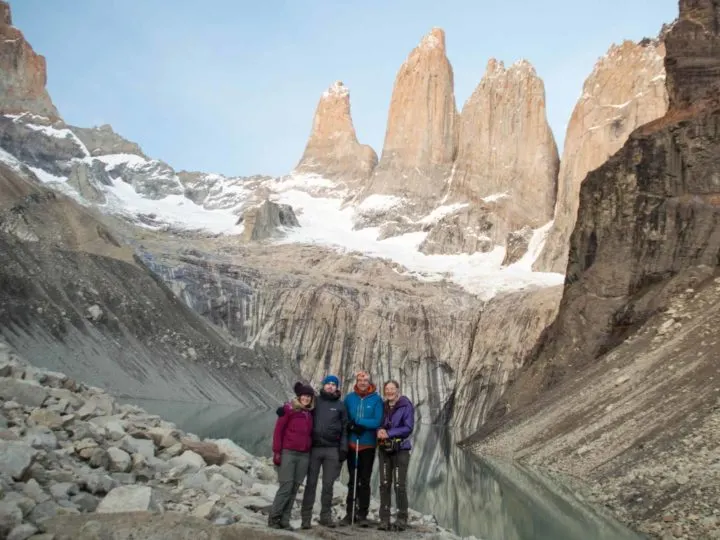
Trust me: you’re about to embark on what will soon rank as one of your favorite hikes in Patagonia.
What is the O Circuit?
The O trek, O Circuit or Full Circuit all refer to the 136-kilometer (85-mile) hike that is the second most popular trail in Torres del Paine National Park in Patagonia*.
The trail begins at the Laguna Amarga entrance to Torres del Paine National Park and completes a full loop of the park, passing anti-clockwise around the back of the Cuernos del Paine, and then up and over the John Gardener Pass and alongside Glacier Grey and the Southern Patagonia Ice Field.
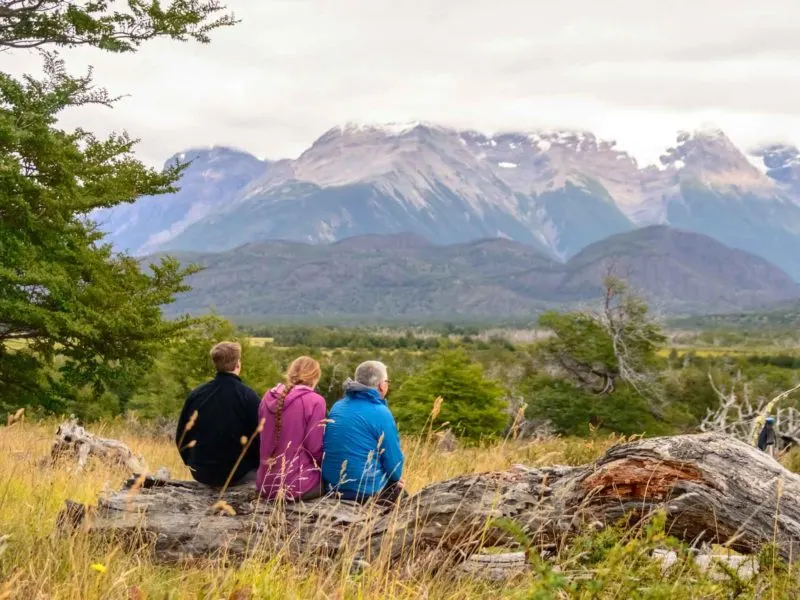
You then join the better-known W trail to end your trek at the striking granite torres (towers) that give the name to the park.
*find out more about the shorter and more popular Patagonia hike, the W or read about the best day hikes in Torres del Paine or this complete guide to Torres del Paine National Park (for hikers and day trippers alike).
Planning Your Trip to Patagonia?
Save time, stress & money with a customized travel itinerary planned for you by a Patagonia expert
But is the O Circuit really accessible for those without much hiking experience and what’s the ideal number of days to aim for?
Do I need to be really fit and an experienced walker to hike the O Circuit in Torres del Paine?
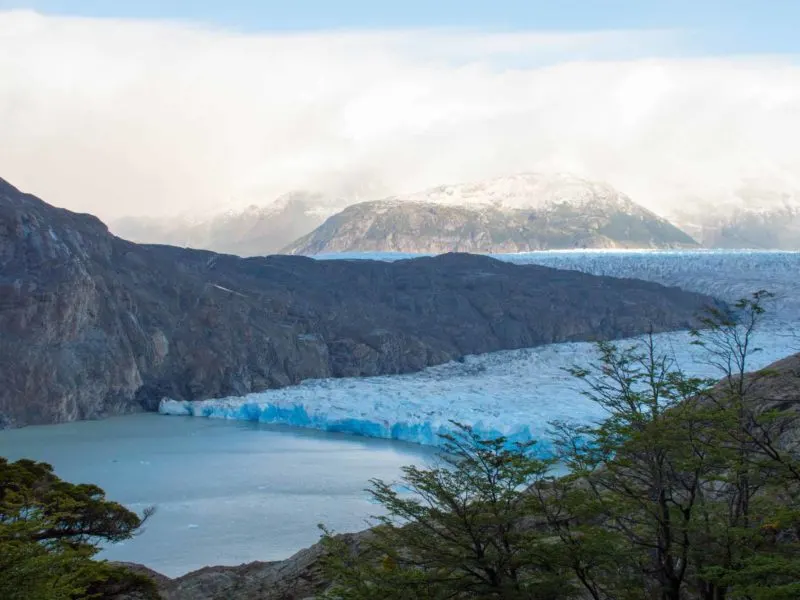
The O trek is a challenging hike; you’re covering 136 kilometers (85 miles) across just nine days, and you’re also gaining significant elevation on two of those days. You’ll also likely be carrying camping equipment and food on your back, which can wind up being very weighty.
However – and I go into this further in my article about the 14 essential things to know before embarking on the O – ultimately anyone can hike the O Circuit.
Sure, it helps if you’ve broken your boots in, have a decent rucksack that fits and won’t cause you discomfort, and know how to cook up a meal with only a stove and a few pots, but realistically, the only barrier to the O Circuit is your own self-belief.
It remains the longest hike I’ve ever done and while I come from a family of walkers (my dad does four-month long-distance hikes around Europe every other year), it was a challenge, but one that could be overcome with preparation.
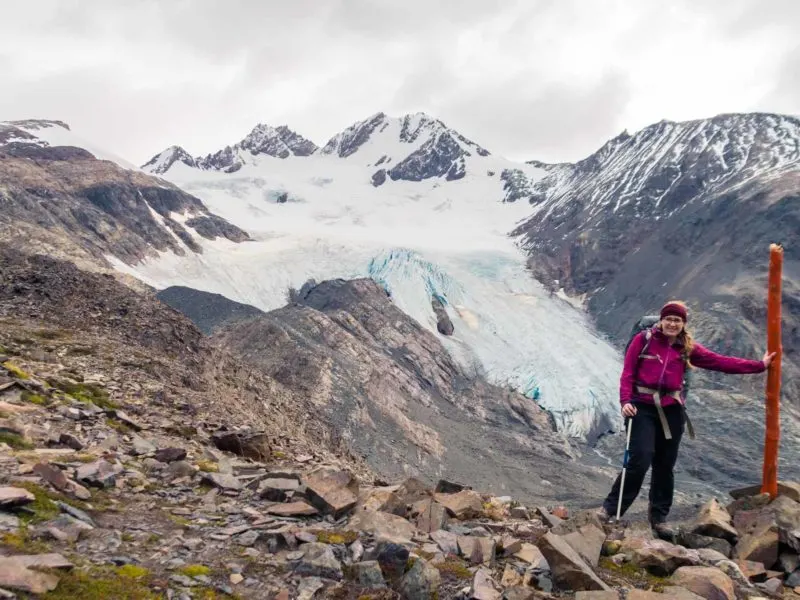
Scroll to the FAQ section of this article for more information about how to prepare for this trek.
What is the distance of the O Circuit?
The O Circuit in Torres del Paine is a 136-kilometer (85-mile) hike*. Depending on your fitness levels and your familiarity with carrying a heavy rucksack, it is possible to hike it in anything from six days to eleven. In general, it takes people nine days to hike the O Circuit.
When we did it, we hiked it in nine days, which is what I’ll use to illustrate the trek in this post. I’ll also indicate where and how you could shorten or extend the number of days.
While you are not obliged to stay at every refugio (refuge) or campground in the park (and instead can turn two of the days on the O Circuit into one if you’re a fast, fit hiker), you are required to hike the O Circuit anti-clockwise.
*Differences in distant lengths abound across the internet for this trek! The distances quoted in this article were recorded during our hike of the O Circuit and include the hike from Laguna Amarga to Serón (rather than from Hotel las Torres to Serón where most people start) as well as the hike back from Hotel Las Torres to Laguna Amarga at the end of the trek (and which many people instead opt to take the minibus transfer).
Which months can I hike the O Circuit?
The official opening date of the O Circuit entirely depends on when CONAF decide to open the trail. This normally happens in November, with the hiking season continuing until the end of March and sometimes into April, with November and March being the best times for visiting the national park and Patagonia as a whole.
During the low season (1st of April until 31st of October), the O Circuit is closed.
Torres del Paine Circuit map
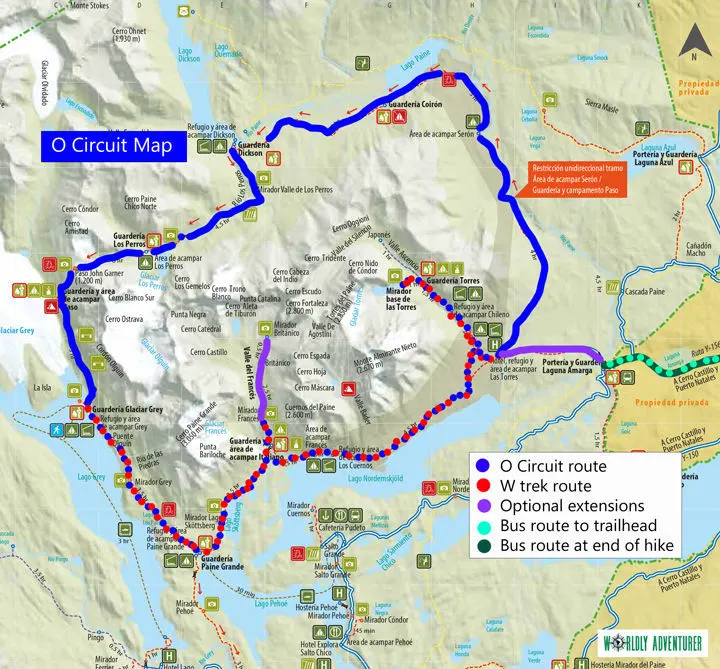
The cost of hiking the O Circuit in Torres del Paine National Park
Unfortunately, trekking in Torres del Paine National Park isn’t cheap. This is because you have to pay for every campground that you stay at, in addition to a fairly high national park entrance fee.
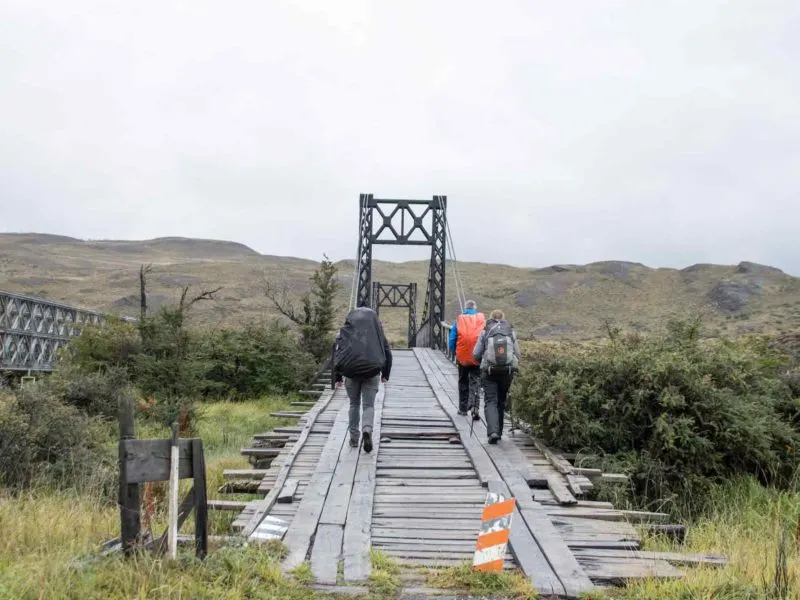
The cheapest way to hike the O Circuit is to bring all of your own food and camping equipment into the national park with you, leaving you to only pay fees for your bus transport, admission into the national park and campgrounds.
If you to backpack the Torres del Paine O Circuit, you can expect to pay $167,000 CLP ($186 USD)*:
- Return bus from Puerto Natales to Torres del Paine National Park: $22 USD
- Adult entrance fee into the park for three+ days: $49 USD
- Serón Campsite: $25 USD
- Dickson Campsite: $10 USD
- Los Perros Campsite: $10 USD
- Grey Campsite: $10 USD
- Paine Grande Campsite: $12 USD
- Francés or Los Cuernos Campsites: $25 USD
- El Chileno or Las Torres Campsites: $25 USD
We also spent only $17,000 CLP ($27 USD) per person for food for the entire trek)
*all figures are per person, based on two people sharing a tent and trekking the O Circuit in nine days
If you don’t want to have to bring camping equipment and instead want a tent, sleeping bag and sleeping mat set up for you at each campground, you can expect to pay $462,000 CLP ($515 USD)*:
- Return bus from Puerto Natales to Torres del Paine National Park: $22 USD
- Adult entrance fee into the park: $49 USD
- Serón Campsite: $70 USD
- Dickson Campsite: $58 USD
- Los Perros Campsite: $58 USD
- Grey Campsite: $58 USD
- Paine Grande Campsite: $60 USD
- Francés or Los Cuernos Campsites: $70 USD
- El Chileno or Las Torres Campsites: $70 USD
*all figures are per person, based on two people sharing a tent and trekking the O Circuit in nine days
If you want to backpack the O Circuit and not carry any food, you can expect to pay an additional $454,000 CLP ($508 USD)* on top of the above prices:
- Serón Campsite: $88 USD
- Dickson Campsite: $61 USD
- Los Perros Campsite: $61 USD
- Grey Campsite: $61 USD
- Paine Grande Campsite: $61 USD
- Francés or Los Cuernos Campsites: $88 USD
- El Chileno or Las Torres Campsites: $88 USD
* all prices are full-board, including breakfast, a packed lunch and dinner
Making camping reservations for the Circuit in Torres del Paine
You can only stay in the official refugios (basic dorm-style accommodation) and campgrounds in the park; wild camping is not permitted and you could well receive a hefty fine for attempting it.
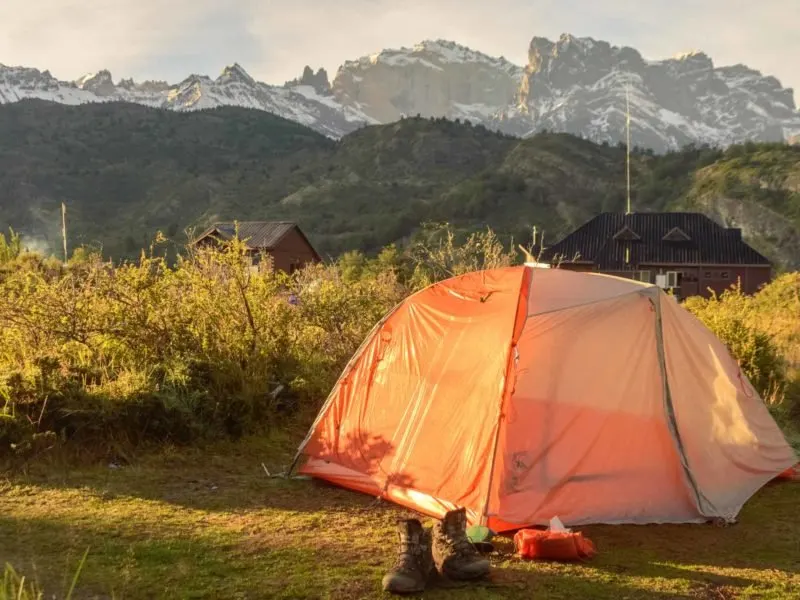
Booking camping pitches or refugio is necessary for hiking the Circuit in Torres del Paine National Park; in fact, you may not be allowed entry into the national park if you cannot show your reservations.
The campground and refuges tend to book up at least four to six months in advance in high season (December through March) and a couple of months in advance for October, November and April.
If you cannot get reservations, it’s sometimes possible to visit the offices in Puerto Natales of Vertice Patagonia and Las Torres (formerly known as Fantastico Sur), who operate the refugios and campgrounds in the park and see if they have space to accommodate you due to a last-minute cancellation.
While you are not obliged to stay at every refugio or campground in the park (and instead can turn two of the days on the O Circuit into one if you’re a fast, fit hiker), you are required to hike the O Circuit anti-clockwise. Therefore, you need to ensure that you make reservations in this direction – you’ll face problems otherwise!
I’ve gone into a surreal level of detail in another post about reservations for Torres del Paine (scroll down for the section about the O Circuit) that should answer all of your questions and give you a sense of prices and facilities available at each of the different overnight stops.
The website Torres Hike shows you the availability of accommodation and allows you to book it directly through them, rather than having to go via the Vertice Patagonia and Las Torres websites. All you need to do is plug in your dates and it’ll show you which campgrounds and refugios are available – saving you LOTS of time.
Equipment for hiking the O Circuit in Torres del Paine
While you can actually stay at refugios every night along the O Circuit (see below), most people instead choose to camp and self-cater – either for monetary reasons or just for the fun of it. This, therefore, adds a considerable degree of weight to your rucksack.
However, every hiker is only as fit and athletic as their rucksack is light and refined.
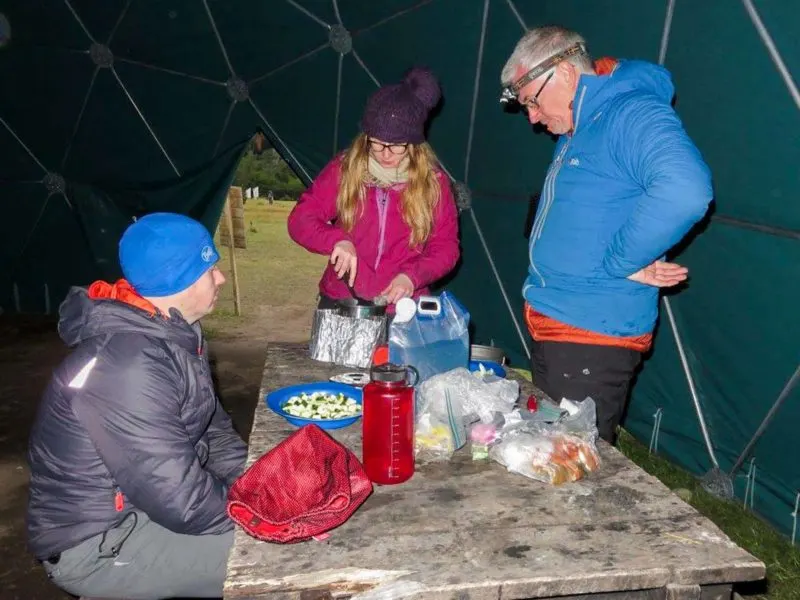
Regardless of how strong you might be, carrying a four-kilogram tent is going to slow you down dramatically. Ditto overpacking clothing that you never wear and lugging heavy gas bottles and saucepans.
Camping and trekking equipment
My dad does some pretty extreme long-distance hiking across Europe and so he knows a thing or two about packing ultralight. I’ve learned from him that to streamline your pack and your speed, I would highly recommend:
I’ve learned from him that to streamline your pack and your speed, I would highly recommend:
- A comfortable 60-liter rucksack. I found 60 liters was perfectly big enough for hiking the full O Circuit – any bigger and you can start to overpack to fill the space; I highly recommend Berghaus, which has a fully adjustable back system and is available on Amazon or check out the highly-regarded Osprey rucksacks for women on REI|Osprey|Amazon and for men on REI|Osprey|Amazon.
- A lightweight backpacking tent. This is likely the heaviest part of your camping equipment and so needs to not weigh you down; I recommend the Big Agnes Copper Spur HVUL 2 Tent (1.4kg/3lb 1oz), which you can find on REI|Backcountry|Amazon. If you’re after a cheaper option and are in the UK, the Wild Country Zephyros 2 is a great alternative. For those on a budget in the US or Canada, check out the North Face Stormbreak 2 (REI|Backcountry|Amazon) or the North Face Stormbreak 3 (REI).
- A warm, lightweight sleeping bag. It can get cold on the O Circuit, so you want something that will still provide the warmth you need but won’t be too bulky or provide unnecessary additional weight; I recommend the Rab Ascent 700 Women’s. If you’re in the States or Canada, for women, the Marmot Trestles 30 (REI|Backcountry|Amazon); for men, the cheaper Marmot Eco Elite 30 (REI|Backcountry).
- A lightweight sleeping pad. A decent sleeping pad is the difference between a comfortable sleep and one spent feeling every single one of the stones underneath the tent; Therm-a-Rest ProLite is good (REI|Backcountry) or find a more inexpensive sleeping pad on REI|Backcountry|Amazon.
- A camping stove and fuel. You want something lightweight but powerful that won’t use up too much fuel (because you have to carry it or buy it for elevated prices at the campgrounds!); the MSR Pocket Rocket is a great option, and can be found on REI|Backcountry|Amazon.
- Camping pots. Again, lightweight and non-stick are your mantras here; Head into your local camping store or buy the MSR pots (REI|Backcountry |Amazon).
- Collapsible bowl. Being able to fold it down saves space and also makes it a slightly less awkward shape to fit in your rucksack. Several companies are now offering these. You can find them on REI|Backcountry|Amazon
- Camping mug. Go for a durable and lightweight plastic or metal one; Pop into your local supermarket or camping store for a cheap one or buy one on REI|Backcountry|Amazon
- Spork or similar. You don’t want to bring much cutlery but you do want something that doesn’t snap in your rucksack; Opt for titanium for more durability such as these ones on REI|Backcountry|Amazon
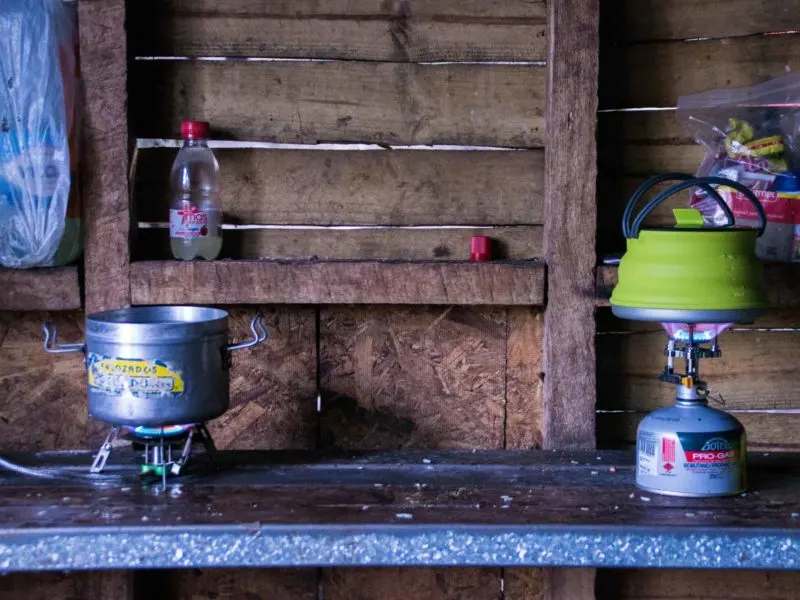
Essentials you might not think about:
- Toilet paper. All of the toilets along the W part of the trek have paper, but many of those on the O Circuit don’t. Don’t get caught out!
- A rain cover for your pack. It rains all the time in Torres del Paine National Park and, if your rucksack doesn’t already come with its own rain cover, I suggest buying one. Just make sure it fits securely, as you don’t want it blowing away. This one by Osprey (REI|Osprey|Amazon) should fit your rucksack without letting water in at the top where the bag straps are.
- A dry sack to be used as a rucksack liner. In case of heavy rain, you also want to make sure that water doesn’t break through into your bag and get all of your clothes wet, which can still happen, even with a rain cover. I suggest a 35- or 40-liter dry bag that can be used as an internal liner for your bag for all items that need to remain dry and closed up inside your rucksack. Check them out on REI|Backcountry|Amazon
- A book or cards. Some of the days are actually quite short in terms of hiking, so a book or pack of cards is great for periods of downtime.
- A charger for your phone or camera. You can actually find electricity in many of the campgrounds (see the full list of facilities available in this guide to camping in Torres del Paine), so you’ll want to bring a charger to make use of them and to keep your electronics alive for all the photographs you’ll take!
For clothing, I would also recommend:
- Hiking boots. You want some that are comfortable and that you’ve broken in (i.e. you’ve worn them on a number of occasions before to loosen up the fabric) so that they don’t give you blisters!; Check out the Salomon hiking boots for women on REI|Backcountry|Amazon or the men’s version on REI|Backcountry|Amazon
- Base layer hiking socks (x3 pairs). I wear a thin pair of socks underneath a thicker pair of socks as I’ve found this helps me avoid getting blisters. You may just want the thicker pair, but it’s worth trialing with both on a hike to see which is most comfortable; Get socks on REI|Darn Tough|Amazon
- Outer layer hiking sock (x2 pairs). As above; Get them on REI|Darn Tough|Amazon
- Gore-Tex waterproof jacket. This is essential for keeping you warm and dry – rain is a very common occurrence in the park, even in summer!; I love the Patagonia Storm10 Jacket as it’s an ultralight, easy-to-pack but fully waterproof jacket (Patagonia); the North Face Alta Vista Jacket (Amazon|REI) is significantly cheaper but offers good weather protection. For him: check out the men’s version of the Patagonia Storm10 Jacket on REI|Backcountry|Patagonia; the North Face Alta Vista (Amazon|REI) is a good shout. I’ve also heard great things about Arc’teryx (REI|Amazon) too
- Waterproof and windproof pants. I bought these last-minute in Puerto Natales and was so thankful I had them to protect me not just from the rain but also from the fierce wind; These zip-off rain pants are great for women: available at REI|Amazon; these rain pants are great for men: available at REI|Amazon.
- Trekking poles. These were essential for the John Gardner Pass, particularly on the way down which was steep and exceedingly muddy. You don’t need to spend loads on them but you do want some that pack down small and light and that are sturdy; Check them out from Black Diamond on REI|Backcountry|Amazon.
- Sandals. We had fairly unusual weather and had to ford a couple of streams that had swollen because of rainfall (something that is very rare but could happen). We found Teva sandals to be the best for this and were also good for evenings when you could wear them with socks and give your feet a break from your hiking boots; Get them for her on REI|Backcountry|Amazon and for him: REI|Backcountry|Amazon – and they’re great for covering long distances in cities comfortably, too!
- Basic short-sleeved or strappy top (x2) for hiking
- Long-sleeved top (x2) for hiking and layering
- Fleece jumper (x2). These are great for the evenings or morning when it’s cold; Check them out for women: REI|Backcountry| Amazon; for men: on REI|Backcountry|Amazon
- Insulated down jacket. Again, these are great for the cold weather in the mornings and evenings and tend to pack down very small and not weigh much; I love my new Jack Wolfskin down jacket (Amazon), as it’s extremely warm and lightweight; REI has great options for men and a helpful guide to choosing one.
- Hiking trousers, zip off at the knee (x2) or shorts. Comfortable trousers that don’t chafe anywhere are essential, while zip-offs allow you to adapt to the weather; Find them for women on REI|Backcountry|Amazon. For men, check these out on REI|Backcountry|Amazon.
- Thermal underwear. I found this was necessary at night time because it can get cold, particularly at the Los Perros and Paso campgrounds; for women: top (Under Armour|Amazon) and bottoms (Under Armour|Amazon); for men: top (REI|Under Armour|Amazon) and bottoms (Under Armour|Amazon)
- Leggings (x1). I use these for either walking or as warm pajama alternatives. Available from REI|Amazon
- Warm hat, gloves, and scarf or a Buff. Again, you want to stay warm in the evenings when the temperature drops and a buff is good wind protection for your neck and face when you’re hiking; Get a buff from REI|Amazon
For further details and advice, check out this article dedicated to helping you decide what is essential to pack for Torres del Paine (i.e. lightweight gear is your friend). And this one about packing for a trip to Patagonia is pretty damn useful too.
Food for the O Circuit
Long-distance hiking requires you to strike the right balance between food that’s lightweight enough that you can physically carry it and meals that provide enough nourishment for you to wake up in the morning.
It’s a delicate balancing act, but one that’s certainly not impossible. Our rule was to pack out our meals with plenty of carbs while including ingredients and condiments that would provide the flavor and make it more than edible.
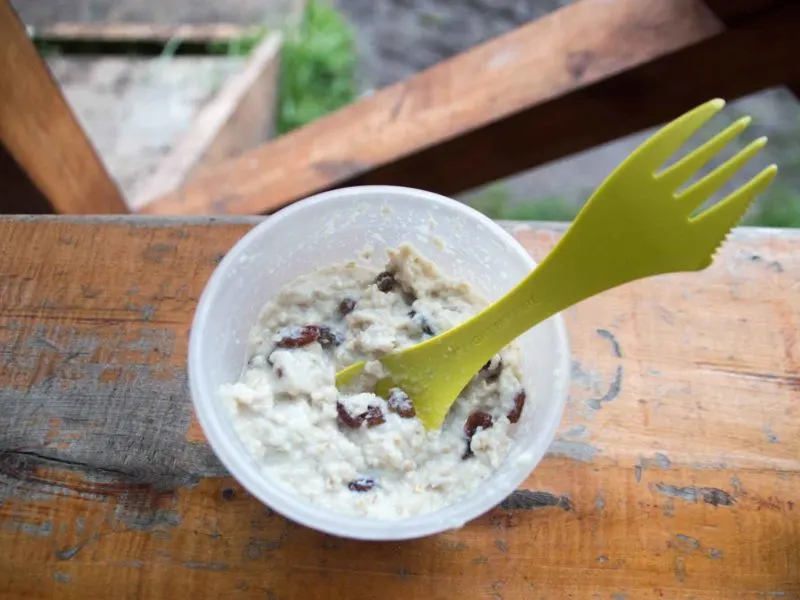
Additionally, we wanted meals that cooked quickly so that we weren’t gnawing our arms off at the end of a long day of hiking and ones that didn’t use up all of our fuel for the camping stove too quickly.
Staple dishes that are both lightweight and easy to cook include:
- Quick-cook porridge made using powdered milk and with added sultanas for flavor and additional energy
- “Sandwiches” made from two biscuits with a wedge of cheese between them
- Dried soup in a cup for a quick energy fix
- Bacon and courgette rice – both flavorsome and packed with carbohydrates!
- Chorizo and tomato pasta – also tasty and really quick to cook
If you don’t have time to organize food when you get to Puerto Natales or you’d prefer to do less cooking, Mountain House have a great selection of pre-prepared trekking food available on REI and Amazon, which just needs you to add water. Bear in mind they are fiendishly expensive and home-cooked food is always tastier – but they’re a good option in a pinch!
For a complete list of the food we carried (on a budget of only $17,000 CLP ($27 USD) per person for the entire trek), check out this article on your Torres del Paine menu.
It also lists where you can find additional food and drinks (i.e. beer) at the various campsites and lodges around the park.
If you’re already traveling around Patagonia, where can you get camping equipment for Torres del Paine?
If you are traveling to Patagonia just to hike the O Circuit or are planning on doing a number of different hikes while you’re there (there are some great national parks along the Carretera Austral, for example), I would recommend bringing your own camping and trekking equipment.
Prices for buying this type of gear in Chile are elevated and you’ll likely pay significantly more than you would buying the same items at home.
However, if you are traveling long-term across South America or don’t want to have to carry all of your camping equipment during the rest of your trip, you have three different options available to you:
Buy equipment in Punta Arenas or Puerto Natales
There are a number of hiking and camping equipment shops in these two towns. Punta Arenas is a tax-free zone so prices here are cheaper than you will find in Puerto Natales, although Calle Manuel Bulnes in the latter has some gear shops.
I actually found a pair of waterproof trousers for only $15,000 CLP ($21 USD) in one of the shops there, which is a lot cheaper than I thought they would be.
If you’re looking to buy equipment for camping and hiking in Torres del Paine National Park, you should be able to find everything that you need in these shops, but you will pay an elevated price for good-quality gear.
Estimated additional cost: $360,000 CLP+ ($400 USD+) per person
Rent equipment from Puerto Natales
Your second option is to rent all of your camping and cooking equipment from either Rental Natales (you can book online but they are very expensive), Yaghan House (O’Higgins 584; contact them here to reserve; they also have a 12pm daily talk about the park) or Lili Patagonico’s (Arturo Prat 479; you can book online here). The latter two have cheap, good-quality rental gear.
Remember to check the equipment thoroughly before committing as it does get a lot of wear and tear on the trail and you want something without holes and with zips that close to keep you warm and dry!
Estimated additional cost: $29,500 CLP ($33 USD) per person per day based on two people sharing a tent
Rent equipment at each campsite in Torres del Paine National Park
Your final option is by the far the most expensive. Each of the main camping grounds in Torres del Paine rents out tents, sleeping bags, and sleeping mats at a premium.
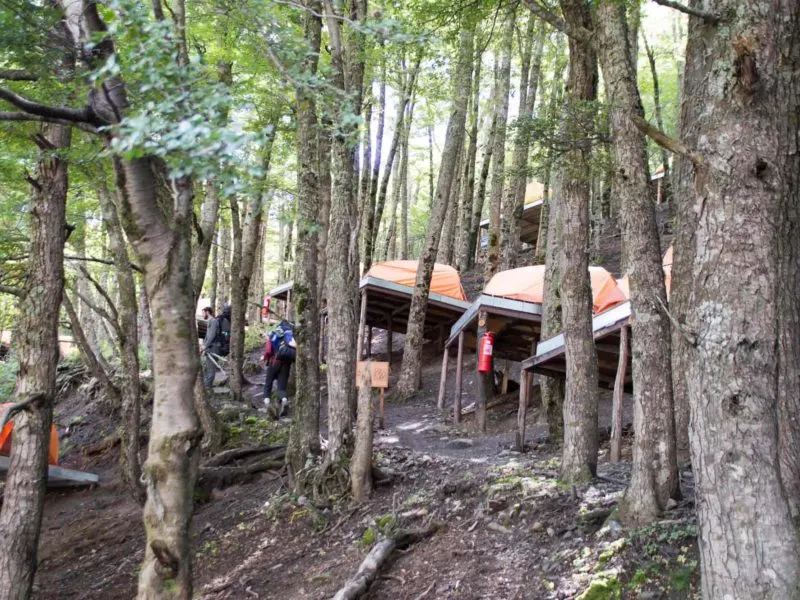
For example, in Grey, you can hire a two-man tent for $29,000 CLP ($32 USD), a sleeping bag for $21,000 CLP ($23 USD), and a sleeping mat for $8,000 CLP ($9 USD), bringing up your overnight cost (including cost of the camping site) to $53,000 CLP ($58 USD) per person per night (based on two sharing).
Bear in mind, this doesn’t include the cost of hiring cooking equipment (which you can’t do at the campsites), so you will also need to pay for meals at each – an additional cost of between $55,000 CLP ($61 USD) and $80,000 CLP ($88 USD).
Estimated additional cost: $462,000 CLP ($515 USD) per person for equipment plus $454,000 CLP ($508 USD) per person for meals for eight days hiking the O Circuit (based on two people sharing a tent).
How to get from Puerto Natales to Torres del Paine National Park
There is plenty of public transport to get you from Puerto Natales to Torres del Paine National Park.
Four companies travel from Puerto Natales to Torres del Paine each morning and all cost around $20,000 CLP ($22 USD) for a return ticket. The return ticket must be used to return with the same company, but can be used on any day or time of bus.
You must buy tickets either online or from the companies’ offices, which are inside the Terminal Rodoviario (Av. España 1455) in Puerto Natales.
If there are a few of you, consider negotiating a group price. We did this and it got us a few thousand pesos off per ticket. It’s advisable to book your bus ticket at least a few days in advance when visiting the park in high season (December through March).
The main bus companies are:
- JB Buses Patagonia (tel. 61/2410 242)
- Transport Maria José (tel. 61/2410 951)
- Buses Juan Ojeda (tel. 9/8943 7808)
- Buses Gómez (tel. 61/2415700)
- Bus Sur (tel. 61/2410 784) – you can book these online and in advance
Between September and April, the buses you want leave at 7am and 7.15am or 7:30am from the bus terminal in Puerto Natales. The buses arrive at Laguna Amarga, where you get off the bus, show your entrance fee (you need to book it here in advance and download the QR code: there is no internet at Laguna Amarga), and start the trek, at 9am and 9.15am/9.30am.
Try and pick an earlier bus; queues can be long for later departures and for those when multiple buses are leaving (and arriving at Laguna Amarga) at the same time.
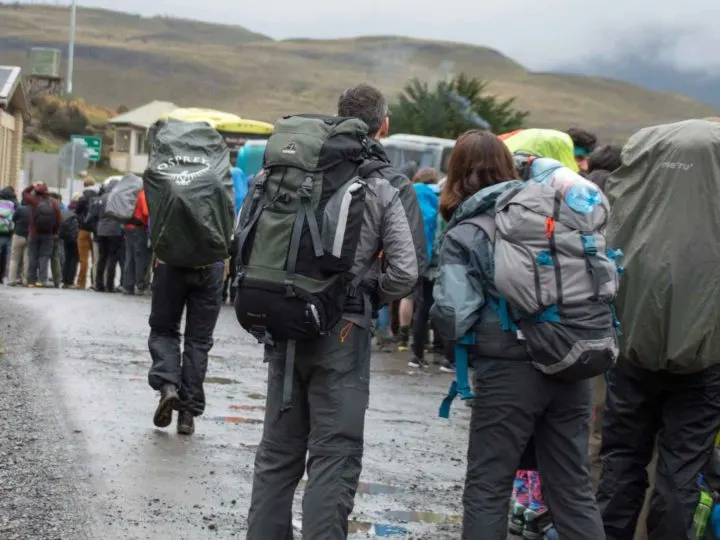
For the return journey from Laguna Amarga, they pick up at 3pm and 7.45pm each day (pre-pandemic they picked up at 11.30am, 1.30pm/2pm/2.30pm, 6.30pm, and 7.45pm each day but I’m not sure if those times are still correct). The exact times depend on the specific bus company; Bus Sur has the most frequent departures.
From Laguna Amarga, you need to:
- Take a minibus shuttle service to the Welcome Centre (Centro de Bienvenida) from where it’s a nine-kilometer (5.6-mile) hike to reach the Serón campground. These buses leave directly from Laguna Amarga at 9am, 3pm, 5pm and 8pm daily (and will wait while people are showing their ticket to enter the park). From here, there are signposts directing you to the O Circuit.
I used to suggest a direct hike from Laguna Amarga to the Serón campsite, a 14.3-kilometer (8.9-mile) route, however this is now closed to hikers. You must begin hiking from the Welcome Centre (Centro de Bienvenida) instead.
Where do you buy your Torres del Paine national park entrance ticket?
The entrance ticket to Torres del Paine National Park costs $35 USD for an adult and $17 USD for children aged 12 to 17 to stay up to three days in the park. If you plan on staying for over three days in the national park, it will cost you $49 USD for both adults and children.
You must book your entrance ticket before you enter the park using this website. You need to download the QR code in Puerto Natales while you have internet (there is no signal in the park) and may need to show a copy of your passport to prove you do not live in Chile.
Hiking the O Circuit in Nine Days
The following day-by-day route description indicates how you can hike the O Circuit in nine days. There are ways that you can adapt the itinerary, either by reducing the number of days or lengthening them. I indicate where the best places to do this are.
Remember, you are only able to camp in the official campgrounds across the national park, which explains why some of the hiking days are very short – but unless you want to combine two days into one, there’s very little you can do to get around this.
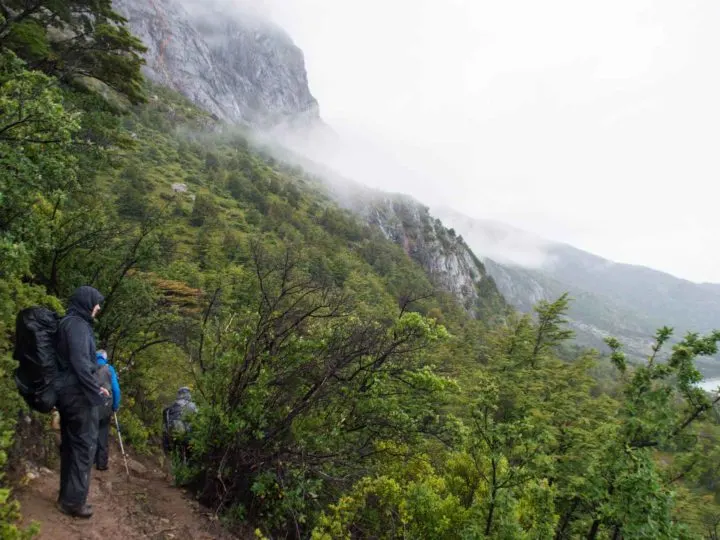
The data and hiking times were compiled from my last trip around the O Circuit. For context, our party consisted of my brother and me (both in our early 30s and reasonably fit) and two mid-60-year-olds (again, reasonably fit). We carried food for all but one day as well as lightweight camping equipment.
Total Distance of the O Circuit: 1362 km (82 mi)
Day One: Laguna Amarga to Serón
Distance hiked: 13 km/8 mi
Hiking duration: Five hours and 30 minutes (including around an hour’s worth of stops).
Average pace: 3.9kph/2.5 mph.
7:00am/7:15am Take the bus from Puerto Natales bus terminal. The early bus you take, the less likely you are to queue behind other hikers to buy tickets when you reach the national park.
9am Arrive at the Laguna Amarga Rangers’ Station and show your pre-purchased ticket (here) to the park rangers. This can take up to an hour, depending on the queues.
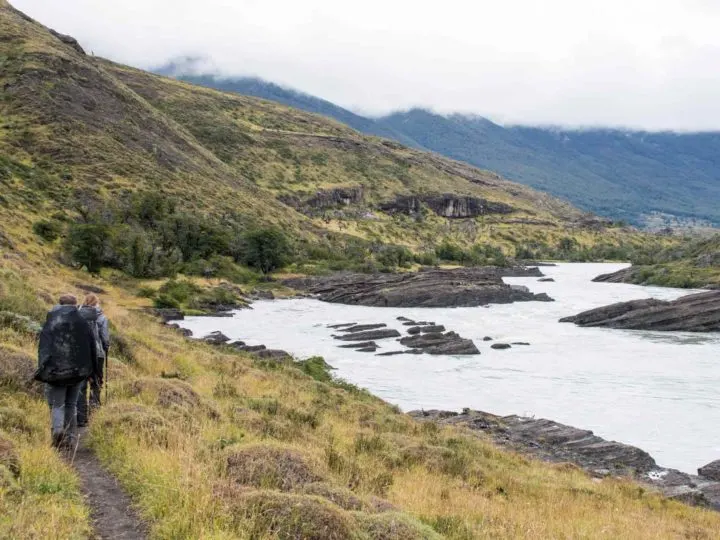
Today is an easy introduction to Torres del Paine National Park. From the ranger’s station at Laguna Amarga, take a minibus shuttle service to the Welcome Centre (Centro de Bienvenida). These buses leave directly from Laguna Amarga at 9am, 3pm, 5pm and 8pm daily (and will wait while people are showing their ticket to enter the park). From here, there are signposts directing you to the O Circuit.
Alternatively, hike to the Welcome Centre (10 kilometers (6.2 miles)) along the road.
When I visited, I took the now-prohibited trail alongside the Río Paine – a tumbling mass of water – for the vast majority of the day. The trail from the Welcome Centre instead hikes through a forest and joins this river around eight kilometers (five miles) into the hike. From there, you follow the river a further five kilometres (three miles) to reach the Serón campground
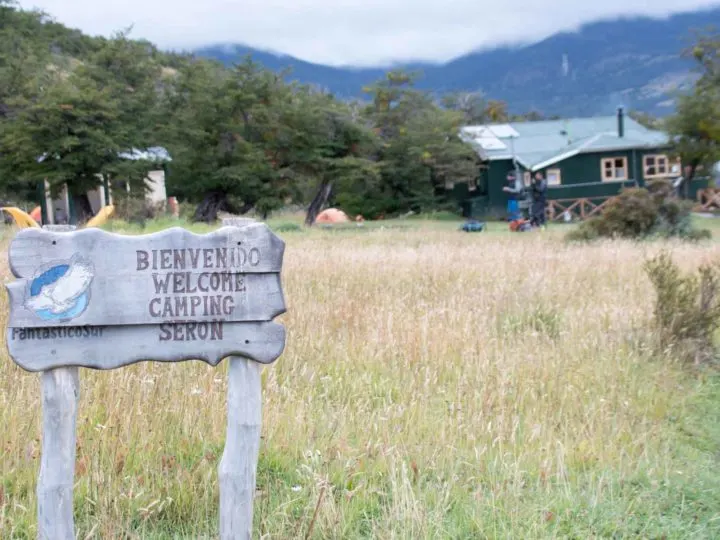
4pm Arrive at the Serón campsite. Find a pitch with a little wind protection (there aren’t very many like this!), enjoy a hot shower if you need it (!), and make use of their covered shelter for cooking dinner.
Day Two: Serón to Dickson
Distance hiked: 18.61 km/11.5 mi
Hiking duration: Six hours 15 mins (including one hour’s worth of stops)
Average pace: 3.63 kph/2.25 mph
Elevation change: Up 534 m, down 495 m
8am Rise early for breakfast and a decent morning start to the day’s hiking.
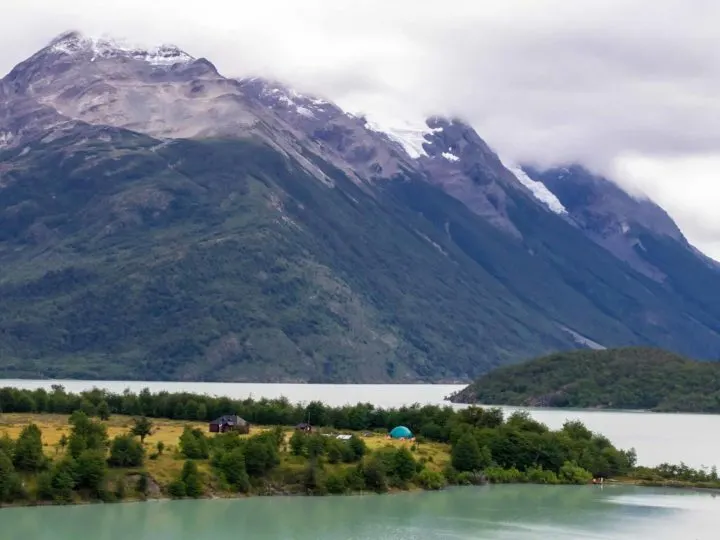
9am Leave camp and begin your trek towards Dickson. The first part of the day is flat as you follow the route of the Río Paine up to Lago Paine. You’ll climb up a number of steep headlands for great mountain views, before continuing along the side of Río Paine towards one of its sources: Lago Dickson.
The views of Lago Dickson and the campground nested on a grassy flat beside are magnificent.
4pm Arrive at Dickson campground and pitch up. There’s a geodesic dome where you’re required to cook all food and various picnic tables dotted around the site for eating. Don’t forget to head to the edge of the river through the woods on the northern side of the campsite to see the hanging glaciers perched vertiginously above Lago Dickson.
Hiking the O Circuit in fewer days: You can combine the trail from Laguna Amarga to Serón and from Serón to Dickson into one long day of hiking. This comes in at 31.6 km (19.6 miles) in total.
Day Three: Dickson to Los Perros
Distance hiked: 12.65 km/7.9 mi
Hiking duration: Five hours 30 mins (one hour 15 minutes of stops)
Average pace: 3 kph/2 mph
Elevation change: Up 575 m, down 208 m
8:30am Wake up and have breakfast
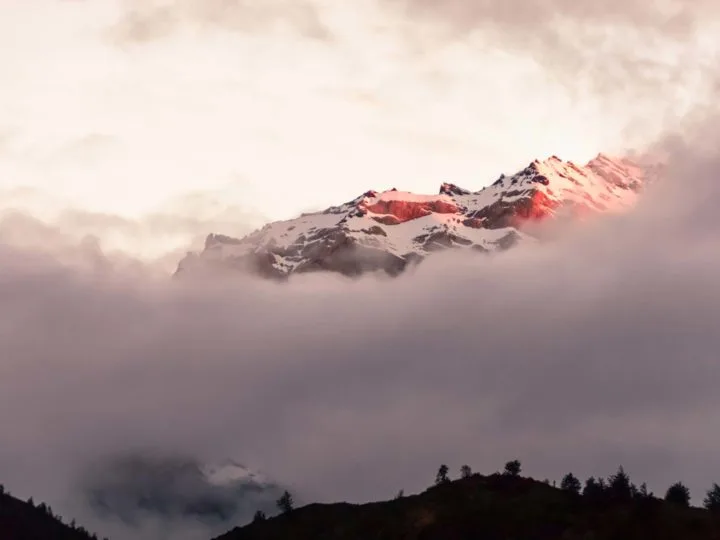
9:30am Leave the camp. The path climbs up into the forest in the south behind the campground, with the trail emerging out of the woods for spectacular views back across the lake in the north and towards John Gardner Pass in the west.
From now on, you can see glaciers in the mountain cliffs ahead, and you’ll pass just before the camp alongside the beautiful Laguna Los Perros, with its namesake glacier hanging above the water.
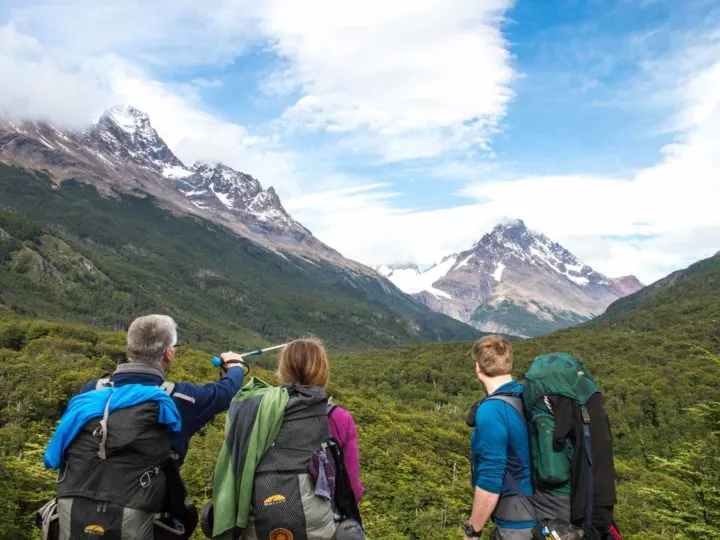
3:30pm Arrive at Los Perros and find a sheltered spot in and among the trees to pitch up. There’s a hut for cooking and eating at the center of the site, which provides good protection from the weather.
Day Four: Los Perros to Grey
Distance hiked: 18 km/11 mi
Hiking duration: 9 hours (two hours of stopping)
Average pace: 2.3 kph/1.43 mph
Elevation change: Up 690m, down 1516m
6:00am Wake up and have a good breakfast – you’re going to need it for today’s climb!
7:00am Leave camp by 7am at the latest. The weather is better and the wind lower in the early morning, so the quicker you make it over Paso John Gardner the better your chances of sensational views across the Southern Patagonian Icefield.
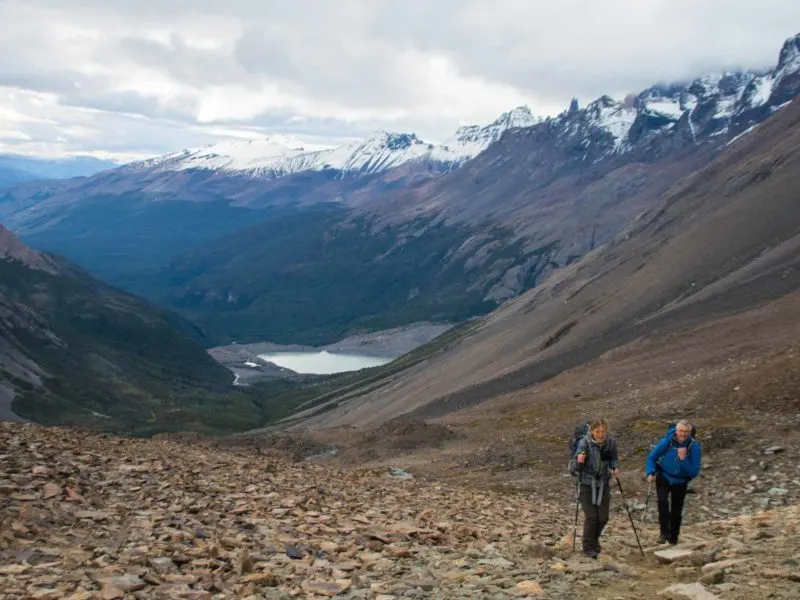
The trail climbs up through scree and boulders, passing hanging glaciers on each side of the narrowing valley.
It’ll take you around three hours to summit the 1,180-metre (3,871-foot) John Gardner Pass John Gardner, from where, on a clear day, you can expect truly astonishing views across the Southern Patagonian Icefield and Glacier Grey. The latter measures around six kilometers wide at this point and is truly incredible.
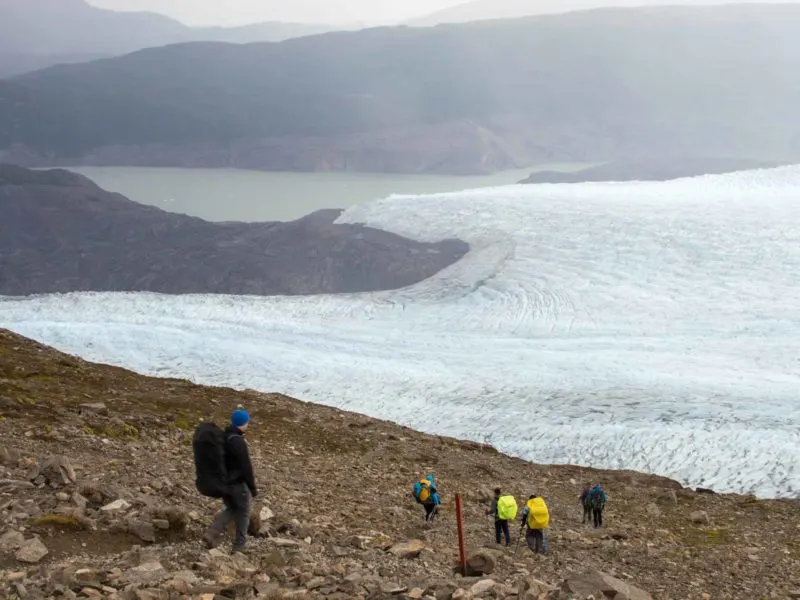
The wind can be fierce, so take things carefully as you begin the climb down, which descends via a series of switchbacks and is generally a bit of a muddy and rocky bog.
The path passes alongside Glacier Grey, which you can see through the trees at regular intervals.
1pm Pass Paso, a former CONAF-run but now closed campsite. Continue to Grey, enjoying the different viewpoints of Glacier Grey. The path goes up and down gently for a while, often with fantastic views of the glacier, before passing into a series of different gullies, some of which you must climb out again with the aid of a metal ladder drilled into the rock.
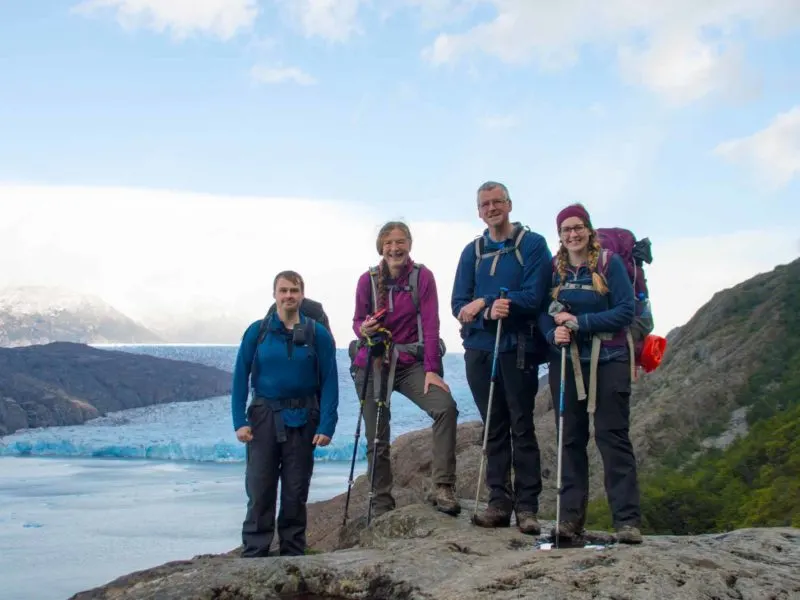
After around 3.6 kilometers (2.3 miles), you reach the first of two wooden bridges perched across two steep river gullies, which can be a trial for anyone with vertigo. Around two kilometers (1.2 miles) after the second, a small pathway leads off the main trail and back to the right; this is Mirador Grey and is the closest viewpoint that you can get of the glacier face on.
5pm Arrive at Grey and stay overnight.
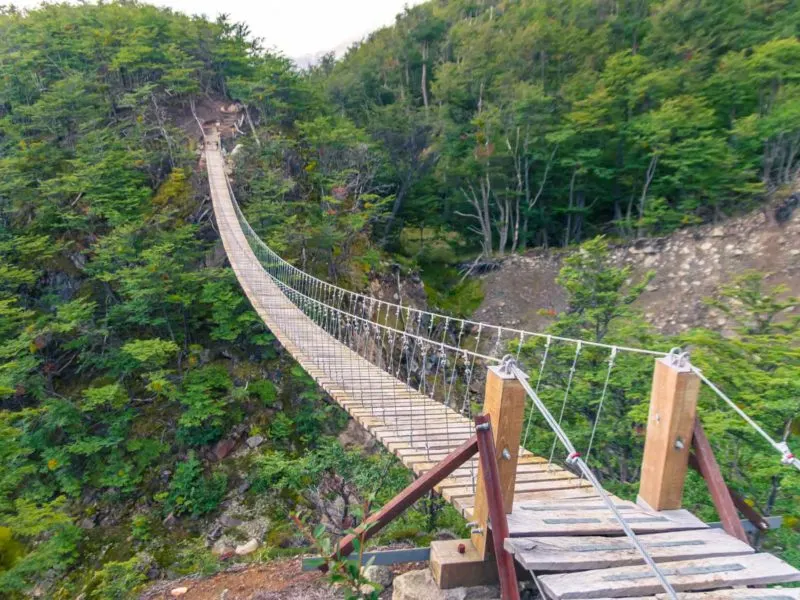
Day Five: Grey to Paine Grande
Distance hiked: 11 km/6.8 mi
Hiking duration: Four hours (one hour of stopping)
Average pace: 2.8 kph/1.75 mph
Elevation change: Up 614 m, down 316 m
8am: Today is a relaxed day, so you can either get up early and go kayaking or ice trekking on the glacier or spend a bit more time in bed.
10am: Take the trail heading south. You’ve now officially joined the W! From here, it’s a further 11 kilometers (seven miles) to reach Paine Grande, with a couple of further viewpoints of the glacier thrown in for good measure. The trail is mostly downhill.
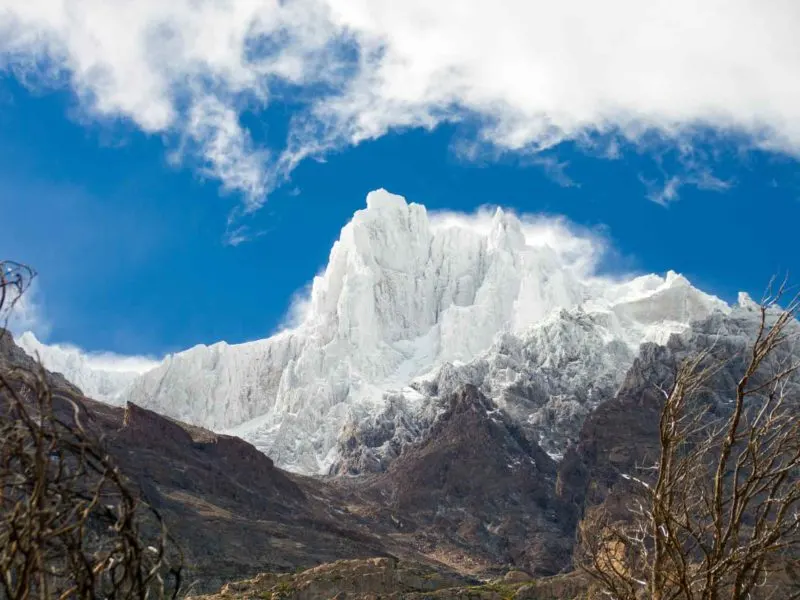
3pm: Arrive at Paine Grande. Pitch up as close to the side of the hill as possible to avoid the wind. There’s a huge shelter with plenty of space for cooking and loads of benches for you to sit and eat. You’ll also find a number of power sockets here.
There are hot showers (four per gender) which open at in the early evening (timings are written on the doors to the toilet block). The queue for the women’s starts early.
Hiking the O Circuit in fewer days: I know of people hiking from Los Perros all the way to Paine Grande. Again, this would be a very long day of hiking and would come in at 26.6 km (16.2 miles) in total.
Day Six: Paine Grande to Francés
Distance hiked: 13 km/8 mi (+ 9 km/5.6 mi for the extension to Mirador Británico), 4 hours hiking
Hiking duration: Five hours 15 mins (one hour 15 mins of stopping) + three hours for extension to Mirador Británico
Average pace: 3.25 kph/2 mph
Elevation change: Up 555 m, down 495 m*
8am: Wake up and eat breakfast. Today will either be long or painfully short – all depending on the weather. Both times I’ve walked Torres del Paine W hike I’ve experienced dreadful weather in the Francés Valley.
9am: Hike to the ranger station and campsite, Campamento Italiano (around two hours), where you leave your rucksack with the ranger. You’ll pick it up on your way back down from the Francés Valley.
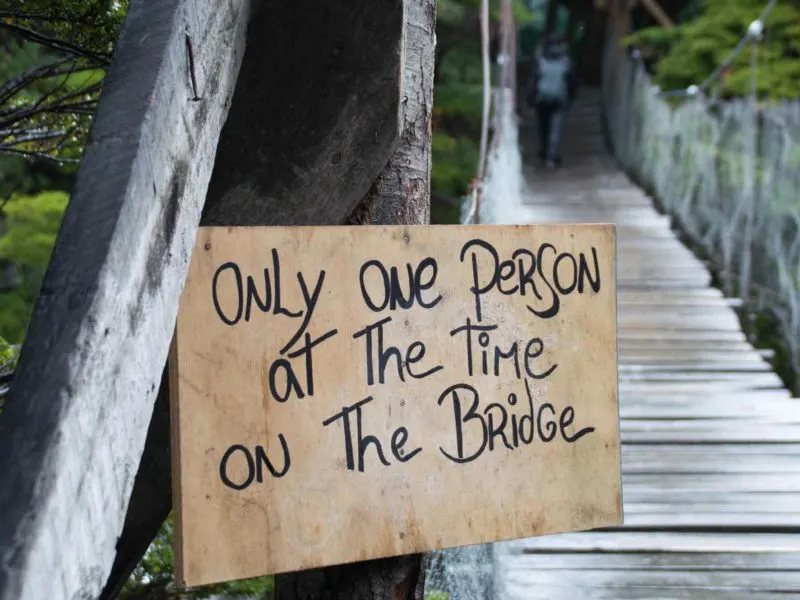
This part of the hike marks the central section of the W and it’s all uphill. After an hour’s steep gradient up a rocky, slippery trail to Mirador Francés, look for Glaciar Francés as it clings to the mountainside in the west.
If you’re feeling energetic, and the weather’s playing fair, you can continue climbing to Mirador Británico (an additional 3.5 km each way; around three hours’ return), where you’ll view a ring of toothy granite peaks, including the park’s second most famous landmark, the three-horned Cuernos del Paine.
It’s one of the park’s most stunning viewpoints—when the sky is clear. You may even see an endangered Southern Andean huemul (a type of deer) around here.
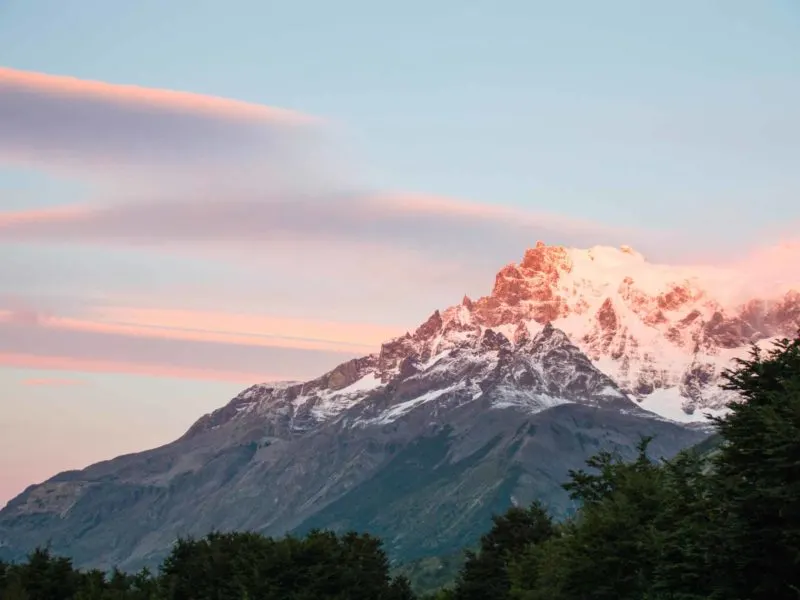
Luckily, the hike back is downhill to return to Italiano, where you pick up your rucksack and hike the 30 minutes to reach Francés.
13:00pm-16:00pm Arrive at Francés**, pitch up (some skill will be required to do this on the wooden platforms. Make sure you bring some string or extra guy ropes to help you), and enjoy the views across the lake. Check-in doesn’t start until 2.30pm and hot showers aren’t available until 5pm, so take your time on the hike if the weather is rubbish and it looks like you won’t be making it up to Mirador Británico!
*because of the weather, we didn’t hike up to the Mirador Británico, so this elevation change doesn’t reflect the 500-meter (1,640-feet) elevation gain to reach the mirador.
*if there is no availability at Francés when you go to make your refugio or campsite reservations, you can instead book to stay at Los Cuernos, which is a further 3.5 kilometers (one hour) from Francés.
Day Seven: Francés to El Chileno
Distance hiked: 17 km/10.5 mi
Hiking duration: Six hours (two hours of stopping)
Average pace: 3.7 kph/2 mph
Elevation change: Up 740m, down 360m
8:00am Get up, have breakfast, and pack up your tent.
9:00am Leave the campsite and begin the trek to El Chileno, situated about two hours from the bottom of the towers.
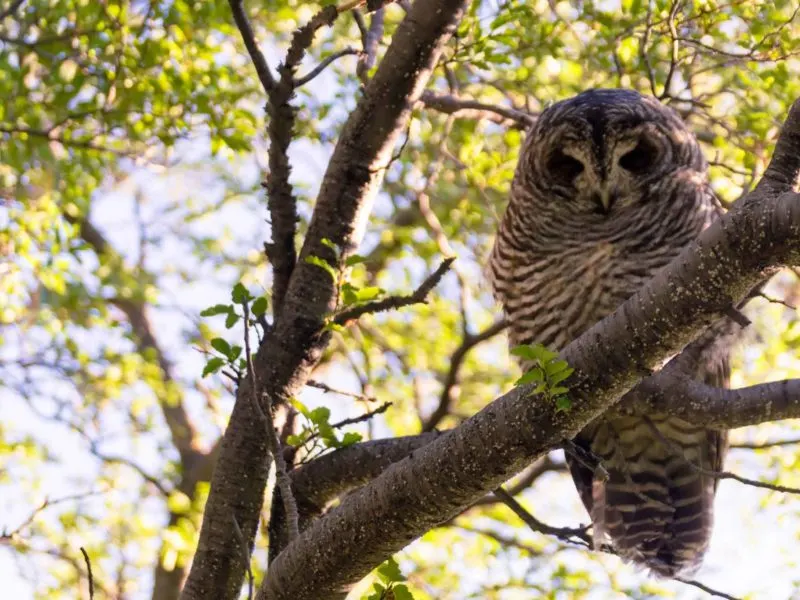
This trek meanders alongside the lake, gaining and losing altitude as it goes, until you reach the start of the valley where it becomes all uphill. The views are incredible but if it’s sunny, it will be hot!
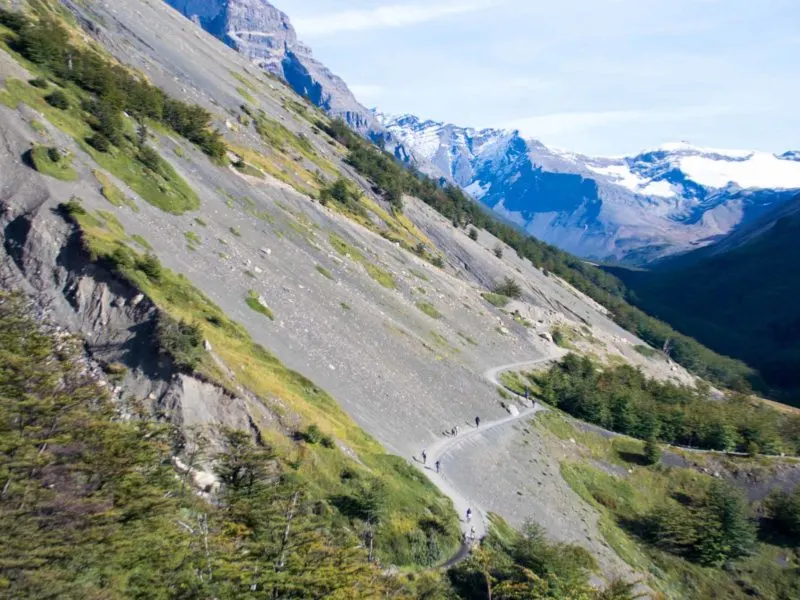
16:00pm Arrive at El Chileno* and pitch your tent. Get everything organized for the morning as you’ll be leaving early. Check with the staff what time sunrise will be the next morning.
*Campamento Torres, the campground just below the towers, is no longer open to the public. It’s not as easy to get to the towers for dawn as the distance is now around four kilometers, rather than one kilometer; however, it is still possible to do it.
If you can’t get a pitch at Chileno, it is possible to hike from Torres Central/Norte ($15,000 CLP ($21 USD) camping pitch per person). Although you’re not officially supposed to hike from here up to the towers, you can: leave four hours ahead of sunrise. It’s an additional one-hour 45 minutes if starting from Torres Central/Norte to reach the towers.
Day Eight: El Chileno to the Torres and then back to Laguna Amarga
Distance hiked: El Chileno to the Torres 3.8 km/2.3 mi; the Torres to Laguna Amarga 17 km/10.5 mi
Hiking duration: Four hours 50 minutes (45 minutes stoppage)
Average pace: 4.5kph/2.8mph up to the towers; 8.33kph/5mph from the Torres to Laguna Amarga
Elevation change: Up 450m, down 450m to and from the towers; Up 150m, down 630m from El Chileno to Laguna Amarga
4:30am Wake up and take a small bag (including warm clothes and a snack) to see the torres at dawn. Don’t forget your torch as the route is over rocks and can be treacherous.
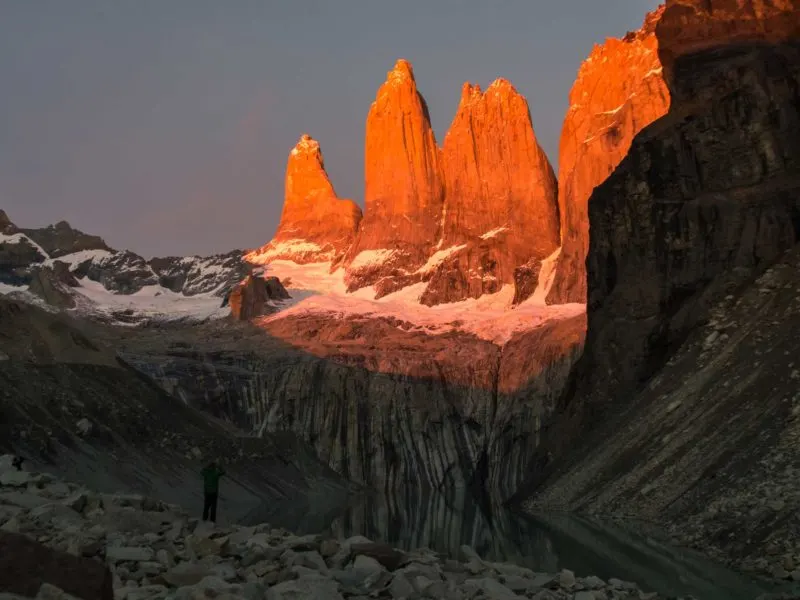
4:45am Start hiking up to the torres. For us at the very start of March, dawn was at about 7:15am.
8:00am Leave the torres and return to the campsite. Pack up, have breakfast start the long walk down.
12.30pm When you get to Las Torres Hotel car park, there is a shop selling ice creams – have one, you deserve it!
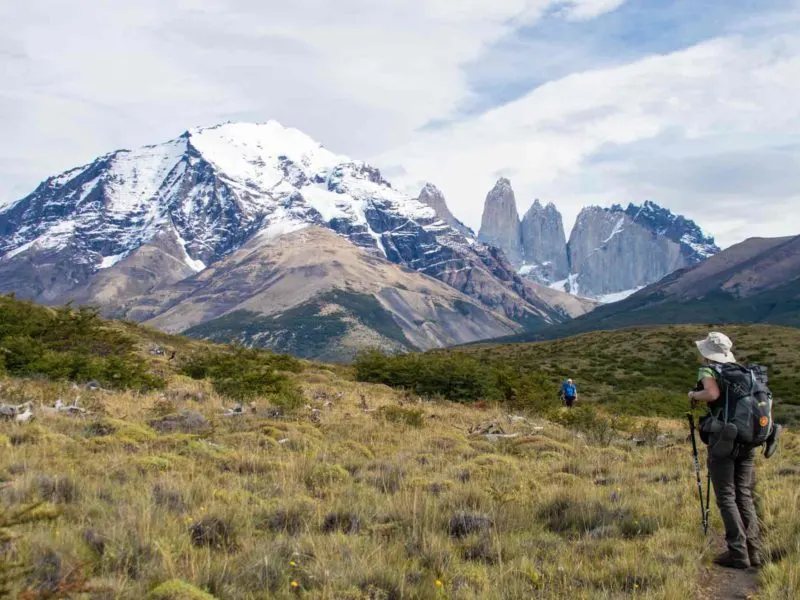
To get the shuttle minibus ($4,000 CLP ($6 USD)) to take you to Laguna Amarga, you need to hike one kilometer down the road towards Torres Central/Norte to reach the Centro de Bienvenida.
Departures leave the Welcome Centre at 8am, 2pm, 4pm and 7pm daily, and take about 30 mins.
If you can face the walk, it’s about another one and a half hours to two hours to the Laguna Amarga Ranger Station where buses are waiting to pick you up.
14:30pm Take the bus from Laguna Amarga back to Puerto Natales.
17:00pm Arrive in Puerto Natales bus station and go and enjoy a pint at Cerveza Baguales on the Plaza de Armas to celebrate!
You’ll most likely need a place to stay for a night or two post-hike, and our guide to the best hotels in Puerto Natales caters to a range of budgets and travel styles.
*If you can’t get a pitch at El Chileno, it is possible to hike from Torres Central/Norte ($15,000 CLP ($21 USD) camping pitch per person). Although you’re not officially supposed to hike from here up to the towers, you can: leave four hours ahead of sunrise.
Make sure you bring a headtorch for climbing in the dark (it will get lighter as you reach the more difficult stretch of hiking just below the towers), plus warm clothing (even including a sleeping bag) to use at the top and keep you cozy as you enjoy the sunrise.
FAQs and further helpful information about the O Circuit
Can you hike the Torres del Paine Circuit with a tour?
Yes, of course. As with the W hike, I don’t think it’s necessary to pay for a tour, particularly as the trails are well-marked and you can book everything online anyway.
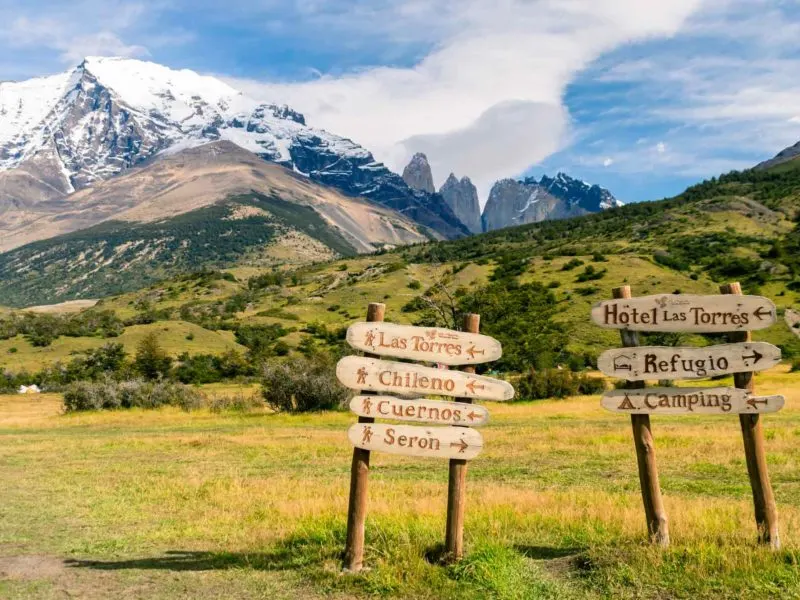
If you would rather avoid the hassle of organizing campgrounds, meals, and transport into the park, you can instead take a tour. These cost upwards of $2,495 USD per person.
Luckily, Chile Nativo in Puerto Natales offer readers a 5% discount on any trek (the Circuit or otherwise) if you include the referral code “Worldly Adventurer” when booking with them!
Otherwise, hiking the O Circuit without a guide is very simple, as the path is well-marked and the terrain, while challenging, is easy enough to traverse.
How can I prepare physically for trekking the O Circuit?
When I hiked the O Circuit, I wasn’t the fittest. However, I have a lot of experience of hiking and I don’t think that your legs ever really lose the muscles that allow you to get up and down hills without too much problem.
Therefore, my biggest recommendation for hiking the O Circuit is to ensure that you’ve done a number of hikes in the months and weeks leading up to the trek. These can range from shorter, eight-kilometer (five-mile) wanders to multi-day treks.
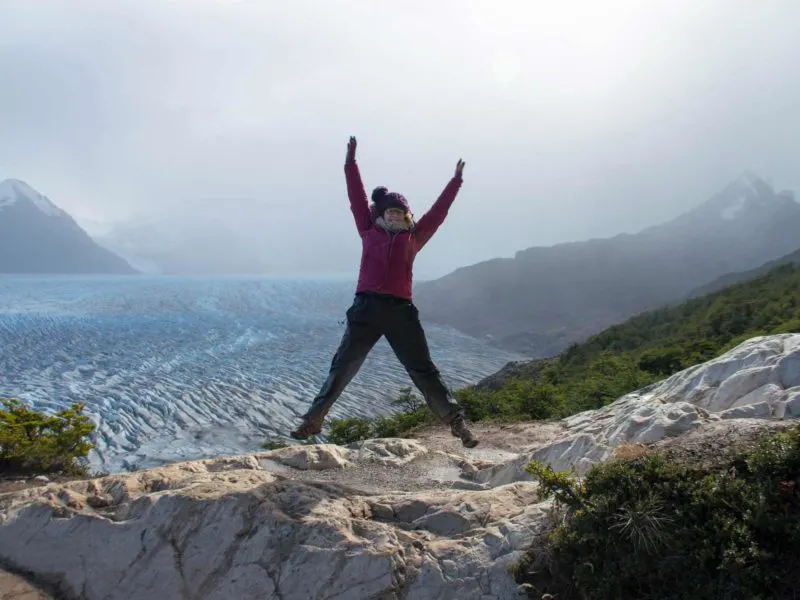
The two most important things to consider during your preparatory hikes are:
- To get used to carrying a rucksack with a heavy load. Our packs weighed in at around 35 pounds (16 kilograms) at the beginning of the trek – although, luckily, they got lighter as we hiked because we ate the food (often the heaviest part of your pack!). Carrying a heavy backpack can hurt your shoulders and it’s essential to know that your rucksack fits properly at the shoulders and the waist so that you carry that weight equally across your back. If you’re not sure how to ensure that your backpack fits properly, check out this article from REI or head into a local outdoor store for advice.
- To do some hill climbing. There are three big climbs on the O Circuit: the gain of around 2,260 feet (690 meters) to summit the 3,871-foot (1,180-metre) Paso John Gardner (the highest point on the trek), the elevation gain of 1,640-foot (500-meter) to hike up to Mirador Británico at 2,300 feet (700 meters) and the 2,300-feet (700-meter) elevation gain to reach the base of the torres at 2,952-feet (900 meters) above sea level on the final day. For all three, you’ll want to know psychologically that you can do it because you’ve hiked up a mountain before – a belief system that I’ve learned is often more important than being physically prepared!
Ultimately, you want to know that you’ll be comfortable getting up each morning, shouldering your pack, and being ready to hike for nine or eleven days solid.
Do you need a map for the Circuit?
Yes, it’s always a sensible idea to have a map indicating your route. These are provided upon entry to the national park (after you pay your admission fee). Unfortunately, they’re not waterproof, so consider bringing a plastic map case or just keeping them out of the rain.
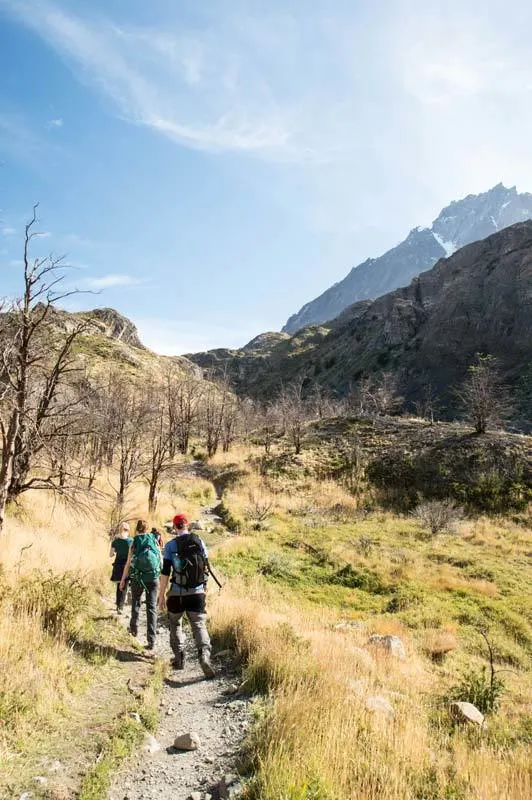
Be aware that, while it helps to know where you’re going, the hiking trails are so well-marked that a map isn’t really necessary for the vast majority of the hike.
I would also recommend downloading maps.me, an app that can be used offline and that shows you the hiking trails in the national park and with which you can use GPS to know exactly where you are.
Top tip: When using maps.me, you MUST zoom into Patagonia on the app and then download the necessary map while you still have an internet connection – maps are only available for regions and countries that you have specifically done this for in advance.
Can you stay in refugios instead of camping for the O Circuit, as you can for the W?
While camping is the most popular way of staying in the park during the O Circuit, if you’re concerned about your ability to carry a heavy pack or just don’t enjoy camping, it is possible to hike the full O Circuit and stay almost every night in a comfortable (if basic!) refugio.
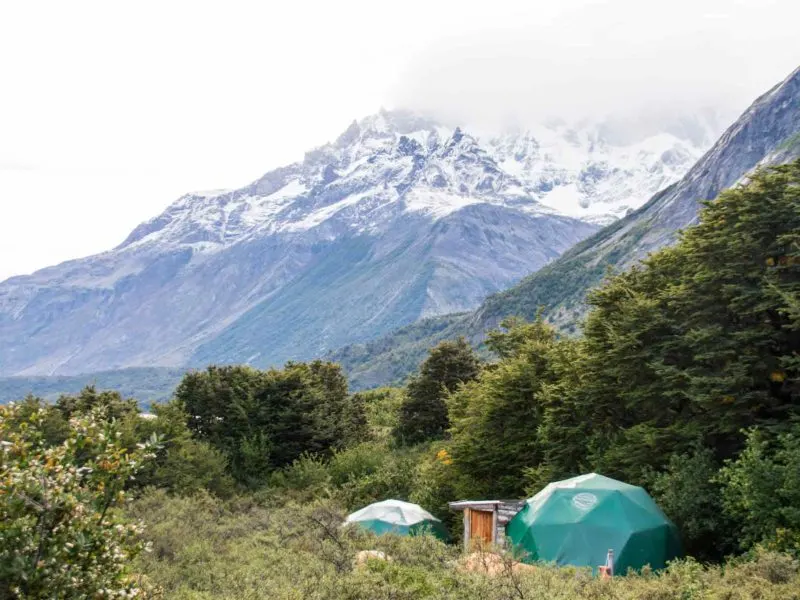
Bear in mind that these consist of very basic accommodation in six-bed dormitory rooms, which can be shared by both male and female hikers. It’s cheaper if you bring your own sleeping bag and you will have access to hot showers and toilets (in some cases a separate set to those used by the campers).
You can self-cater if you choose to stay in the refugios, but a lot of people choose to go all in and get meals provided at (almost!) every place.
Your only issue is that day one, Campamento Serón and day three, Campamento Los Perros, only have accommodation in tents.
You can expect to pay $1,031,800 CLP ($1,151 USD)*:
- Return bus from Puerto Natales to Torres del Paine National Park: $22 USD
- Adult entrance fee into the park: $49 USD
- Serón Campsite: $125 USD dorm bed in refugio + $88 USD full board
- Dickson Campsite: $40 USD dorm bed in refugio (excluding sleeping bag) + $61 USD) full board
- Los Perros Campsite: $58 USD fully-equipped tent + $61 USD full board
- Grey Campsite: $40 USD dorm bed in refugio (excluding sleeping bag) + $61 USD full board
- Paine Grande Campsite: $59 USD dorm bed in refugio (excluding sleeping bag) + $61 USD full board
- Francés or Los Cuernos Campsites: $125 USD refugio + $88 USD full board
- El Chileno or Las Torres Campsites: $125 USD refugio + $88 USD full board
*all figures are per person and trekking the O Circuit in nine days
If you plan on staying in the refugios, you can get away with a 40-litre pack and even smaller if you decide to go fully catered, as all you will need to pack clothing for the duration of the hike.
- You still want a 40-litre backpack that provides decent back support and has a hip strap to support the way that the bag sits on your back. I would highly recommend the Osprey Tempest 40-litre rucksack for women (REI|Osprey|Amazon) and the Osprey Talon 44-litre rucksack for men (REI|Osprey|Amazon)
Can you hike the Torres del Paine Circuit clockwise?
It’s no longer possible to hike the O Circuit counter-clockwise, and although one way that you can amend the route is by entering the O Circuit at Paine Grande (take the Hip Sur catamaran across the lake; information and itineraries here), hike east to Frances/Los Cuernos, Torres Central/Chileno and then to Seron and continue along the O, finishing where you started at Paine Grande.
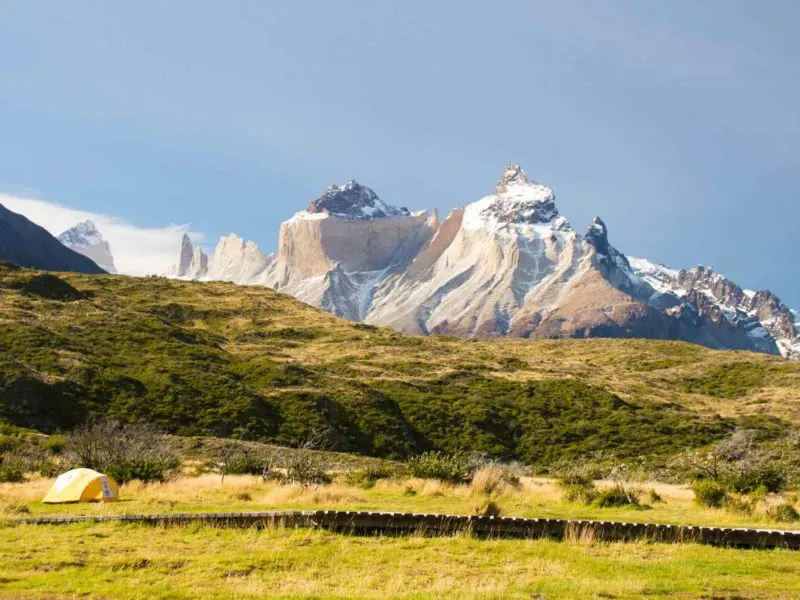
From Paine Grande, you can then leave the park along a trail that takes you to Administración, the ranger station in the southwest of the park. This trail has outstanding views back towards Los Cuernos and will add an extra day to your route, with you hiking what is known as the Q Circuit (again for the shape that it makes on the map).
Note: you can only hike this trail south from Paine Grande, not north from Administración.

Jill Kuz
Friday 26th of January 2024
Do you need to bring a water filter or is there potable water at the campsites? Thanks!
Steph Dyson
Friday 9th of February 2024
There is potable water at the campsites. Steph
Kara
Saturday 26th of August 2023
Thanks for all your information!! I'm looking to book for Jan 2024, but I can't figure out if it's too early? How far in advance can you book, do you know?
Steph Dyson
Wednesday 20th of September 2023
Hi Kara, you need to book asap. January is peak travel month and you might struggle to find availability now. Steph
Pavan Pakala
Tuesday 4th of July 2023
Hey Steph,
Can I buy park fees ahead of time or can I pay before starting the hike at the entrance? We are doing the O circuit in mid-december and got all the campsites booked. I am seeing conflicting information that we can buy ahead of time. Appreciate the clarification. Thx pav
Steph Dyson
Wednesday 5th of July 2023
Yes you need to. Buy them here: https://aspticket.cl/ As with everything, it's incredibly glitchy though. Steph
Pavan Pakala
Monday 26th of June 2023
Hey Steph, Thanks for everything you to provide awesome info. Approximately, how many refugios and/or camp permits is given per day on the O circuit? I am curious what the numbers are for our planning purposes since we may have large group to travel in mid December. Thx!
Steph Dyson
Wednesday 5th of July 2023
Hi Pavan, 70 hikers are permitted each day. Steph
Pavan Pakala
Sunday 25th of June 2023
Hey Steph, Thanks for all the wonderful info. We are also planning the O circuit either in mid December or late February.
I know there are couple of aggregator websites that allows to book all campsites from one place. Would appreciate any thoughts on the differences between the following sites. https://torreshike.com/en/ https://www.bookingpatagonia.travel/#/ Thanks!
Steph Dyson
Wednesday 5th of July 2023
Thanks for the kind words Pavan! I've never used Booking Patagonia but finds Torres Hike is brilliant (although they've had a few problems these past few days because Vertice is rubbish and keeps messing up their system). Steph